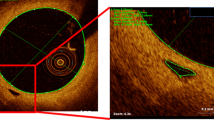Abstract
Observations indicate that advantitial vasa vasorum may play a role in the development and/or the progression of coronary atherosclerosis. There is a lack of information regarding the spatial three-dimensional pattern of the vasa vasorum in the coronary artery. This is due to the technical difficulties in visualizing the course of this fine vascular network with histologic methods. Microscopic computed tomography (micro-CT) is a novel technique that allows three-dimensional views of the entire microvascular structure. The current review summarizes our current advances in using this technique in visualization of the coronary circulation.
Zusammenfassung
Das Studium der Anatomie und Funktion der Vasa vasorum von großen Gefäßen hat zunehmende Bedeutung gewonnen. Die Vasa vasorum der menschlichen Koronararterien bilden ein feines Netzwerk der mikrovaskulären Strombahn, die sich vor allen Dingen im Bereich der Adventitia befindet und das Gefäß mit Sauerstoff und Nährsubstanzen versorgt.
Im Stadium der fortgeschrittenen Arteriosklerose sind experimentell und pathologisch-anatomisch Veränderungen der adventitiellen Vasa vasorum nachgewiesen worden. Es besteht eine enge Beziehung zwischen dem Ausmaß der Neovaskularisation und dem Schweregrad der Arteriosklerose. Außerdem konnte experimentell gezeigt werden, daß eine Verletzung der adventitiellen Schichten der Gefäße die Proliferation der Intima stimuliert. Unbekannt ist bisher gewesen, ob die Proliferation der Vasa vasorum der Entwicklung der Plaqueformation vorausgeht oder eine Folgeerscheinnung darstellt. Die neu entwickelte mikroskopische Computertomographie erlaubt erstmalig eine dreidimensionale Ansicht der mikrovaskulären Struktur. Mit Hilfe dieser Technik ist eine räumliche Darstellung der Gefäßversorgung möglich. Dabei hilft besonders die dreidimensionale Rekonstruktion. In Kombination mit Druckanalysen kann die intramurale Wandspannung unter Veränderung der Methoden der Finiten Elemente berechnet werden.
Erste Untersuchungen werden vorgestellt, die bei Schweinearterien durchgeführt worden sind. Die Tiere wurden mit cholesterinreicher Kost gefüttert. Im Mikro-CT wurde eine signifikante Steigerung der Dichte der Vasa vasorum in den Koronargefäßen festgestellt. Ähnliche Befunde fanden sich auch an menschlichen Koronararterien. Werden bei Koronararterien Dilatationen und Stentimplantationen durchgeführt, findet sich ebenfalls eine starke Zunahme der Dichte der Vasa vasorum der Adventitia.
Die Mikro-CT-Analyse der Vasa vasorum der koronararterien erleubt ein neues Verständnis der Entwicklung der koronaren Herzerkrankung. Neue Informationen werden zur Definition der Plaquestabilität erwartet. Die Stentimplantation führt nach der Verletzung zur Kompression der Versorgung und damit zu einer Ischämie, die in einer lokalen Proliferation und Stimulation der Angioneogenese resultiert. Die Analyse des Mikro-CT wird möglicherweise dazu beitragen, neue Stentdesigns zu entwickeln, die weniger stark die Vasa vasorum kompromittieren.
Similar content being viewed by others
References
Avula RTV, Dunsmuir JH, Beighley PE, et al. A microtomographic technique enhanced by novel image reconstruction algorithm: application to rat coronary vessels. FASEB J 1994;8:A854.
Barger AC, Beeuwkes R, Lainey LL, et al. Hypothesis: vasa vasorum and neovascularization of human coronary arteries. N Engl J Med 1984;310:175–7.
Barker SGE, Talibert A, Cottam S, et al. Arterial intimal hyperplasia after occlusion of the adventitial vasa vasorum in the pig. Arterioscler Thromb 1993;13:70–7.
Booth RFG, Martin JF, Honey AC, et al. Rapid development of atherosclerotic lesions in rabbit carotid artery induced by perivascular manipulation. Atherosclerosis 1989;76:257–68.
Chilian WM. Coronary microcirculation in health and disease: summary of an NHLBI workshop. Circulation 1997;95:522–8.
Flannery BP, Dickman HW, Roberge WG, et al. Three-dimensional X-ray micro tomography. Science 1987;237:1439–44.
Heistad DD, Marcus ML. Role of vasa vasorum in nourishment of the aorta. Blood Vessels 1979;16:225–38.
Jorgensen SM, Demirkaya O, Ritman EL. Three-dimensional imaging of vasculature and parenchyma in intact rodent organs with x-ray micro-CT. Am J Physiol 1998;275(Heart Circ Physiol 44):H1103–14.
Kumamoto M, Nakashima Y, Sueishi K. Intimal neovascularization in human atherosclerosis. Its origin and pathophysiological significance. Hum Pathol 1995;26:450–6.
Kwon HM, Sangiorgi G, Ritman EL, et al. Adventitial vasa vasorum in balloon injured coronary arteries: visualization and quantitation by a microscopic three-dimensional computed tomography technique. J Am Coll Cardiol 1998;32:2072–9.
Kwon HM, Sangiorgi G, Ritman EL, et al. Enhanced coronary vasa vasorum neovascularization in experimental hypercholesterolemia. J Clin Invest 1998;101:1551–6.
Martin JF, Booth RF, Moncada S. Arterial wall hypoxia following thrombosis of the vasa vasorum is an initial lesion in atherosclerosis. Eur J Clin Invest 1991;21:355–9.
Okuyama K, Yoegashi H, Takahashi T, et al. The three-dimensional architecture of vasa vasorum in the wall of the human aorta. A computer aided reconstruction study. Arch Pathol Lab Med 1988;112:726–30.
Phillips GD, Stone AM, Schultz JC, et al. Age-related alterations in the morphology of femoral artery vasa vasorum in the rat. Mech Ageing Dev 1995;82:149–54.
Ritman EL, Dunsmuir JH, Faradani A, et al. Local reconstruction applied to X-ray tomography. In: Chavent G, Panicolaou G, Sack P, Symes W, eds. Inverse problems in wave propagation. IMA volumes in mathematics and its applications, Vol 90. New York: Springer, 1997;443–52.
Sugiura, N. An experimental study on the vasa vasorum of the venous graft used in arterial replacement. Jpn Circ J 1968;32:727.
Tsikaras DP, Natsis K, Hytiroglou P, et al. Microanatomy of the vasa vasorum of the human thoracic aorta: a study utilizing a polyester resin casting technique. Bull Assoc Anat (Nancy) 1997; 81:21–2.
Williams JK, Armstrong ML, Heistad DD. Vasa vasorum in atherosclerotic coronary arteries. Responses to vasoactive stimuli and regression of atherosclerosis. Circ Res 1988;62:515–23.
Wolinsky H, Glagov S. Nature and species differences in the medial distribution of aortic vasa vasorum in mammals. Circ Res 1967;20:409–21.
Zamir M, Silver MD. Vasculature in the walls of human coronary arteries. Arch Pathol Lab Med 1985;109:659–62.
Zamir M, Silver MD. „Hemorrhagic” and microvascular phenomena within arterial wall. Can J Cardiol 1992;8:981–4.
Author information
Authors and Affiliations
Corresponding author
Rights and permissions
About this article
Cite this article
Lerman, A., Ritman, E.L. Evaluation of microvascular anatomy by micro-CT. Herz 24, 531–533 (1999). https://doi.org/10.1007/BF03044224
Issue Date:
DOI: https://doi.org/10.1007/BF03044224




